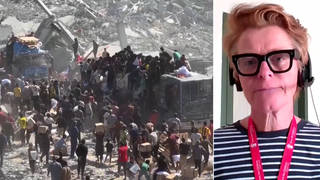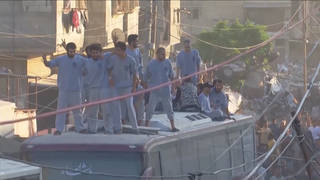
Guests
- Tom Diazjournalist and lawyer and the author of four books, including his latest, The Last Gun: How Changes in the Gun Industry Are Killing Americans and What It Will Take to Stop It. He is a former senior policy analyst at the Violence Policy Center.
Three days after the mass shooting at the Washington Navy Yard, investigations are underway into the gunman Aaron Alexis’s deadly rampage that left 12 people dead. Lawmakers are questioning how Alexis maintained a security clearance at the base despite a history of violent episodes and mental illness. But there is little momentum on Capitol Hill to enact any new gun-control laws. “We are at a defining point in America: What kind of society are we going to be?,” asks Tom Diaz, author of “The Last Gun: How Changes in the Gun Industry Are Killing Americans and What It Will Take to Stop It.” Diaz is a former member of the National Rifle Association and is a gun enthusiast.
Transcript
JUAN GONZÁLEZ: Two days after the mass shooting at the Washington Navy Yard, investigations are underway into the gunman Aaron Alexis’s deadly rampage that left 12 people dead. Lawmakers are questioning how Alexis maintained the security clearance at the base despite a history of violent episodes and mental illness. Rhode Island police warned the U.S. Navy last month that Alexis had reported hearing voices and that he believed people were following him and, quote, “sending vibrations” into his body. Police in Newport, Rhode Island, were so concerned about his behavior that they alerted the Navy police. Alexis also reportedly contacted two Veterans Administration hospitals recently and was believed to be seeking psychological help.
AMY GOODMAN: Aaron Alexis was granted a security clearance in 2008, even though a security check had uncovered a 2004 arrest on a charge of malicious mischief. Alexis had reportedly been arrested when police said he shot the tires of a construction worker’s car with a Glock .45-caliber handgun. He later described the incident as anger-fueled “blackout,” according to a police report. On Wednesday, Defense Secretary Chuck Hagel admitted there had been red flags that could have alerted officials that Alexis had a history of mental health issues and should not a been granted access to the Navy base.
DEFENSE SECRETARY CHUCK HAGEL: Obviously, when you go back in hindsight and look at all this, there were some red flags. Of course there were. And should we have picked them up? Why didn’t we? How could we have? All those questions need to be answered. Where there are gaps, we will close them. Where there are inadequacies, we will address them. And where there are failures, we will correct them. We owe the victims, their families and all our people nothing less.
JUAN GONZÁLEZ: More details have also emerged about the guns Alexis used in his attack. He reportedly tried to buy an AR-15 assault rifle at a gun store in Virginia just last week, but was stopped because the state’s laws banned such sales to out-of-state buyers. Instead, he bought an 870 Remington pump-action shotgun that he used in the Navy yard attack. Officials in Virginia say he passed both state and federal background checks, despite at least two gun arrests and being under treatment for psychiatric problems. He reportedly used shotgun shells that had large ball-bearing shots in them. Officials say it is still unclear if Alexis’s psychiatric issues ever resulted in him being committed to a mental health institution involuntarily or declared illegally—declared legally mentally ill, which would have barred him from buying a gun.
AMY GOODMAN: Analysts are also trying to determine the meaning of two phrases that were etched into the side of his shotgun. In an area closest to where bullets were loaded, they found the phrases “Better off this way” and “My ELF weapon” etched into the metal. ELF may be a reference to extremely low frequency radio waves the Navy uses to communicate with submarines.
Well, for more, we’re joined by Tom Diaz. He’s a former member of the National Rifle Association and gun enthusiast. He later worked for years at the Violence Policy Center, author of four books, his latest, The Last Gun: How Changes in the Gun Industry Are Killing Americans and What It Will Take to Stop It.
Welcome to Democracy Now!, Tom. You’re speaking to us from Washington. What’s happening in Washington right now? I mean, the Washington Navy Yard is, to say the least, close to Capitol Hill. We are wondering at this point what Capitol Hill, what Congress is going to do about this latest mass shooting?
TOM DIAZ: Well, I think Congress has already done what it’s going to do, which is pretty much nothing. There was a press conference yesterday where—it’s almost heartbreaking to see families of victims come to Washington yet again with a letter and a press conference at which members of Congress, the minority leader and a few other Congresspeople and one senator expressed their condolences. This is the equivalent of lighting candles and mounting up teddy bears and doing nothing.
The truth of the matter is that, on this issue, as in so many others, Washington is paralyzed. And there are reasons for that, which we can discuss in further detail if you wish. But the fact of the matter is that the nation cannot turn its lonely, shocked eyes to Washington and expect action. It is not going to happen.
JUAN GONZÁLEZ: And what do you make, once again, to one of these mass shootings, of the discussions over the relationship between individuals with mental health problems having access not only to guns, but to military-style assault weapons?
TOM DIAZ: Yes, there are, I think, three ways to look at that specific problem. One of them is the public health and safety approach. That’s not a mystery. We know that the combination of mentally ill people, and even in many cases, up until the moment they pull the trigger, mentally healthy people who act out in moments of rage or depression or what have you—we know that when you take that combination of mental state and combine it with a firearm, you have a recipe for trouble, as we’ve seen over and over again, and increasingly so in the last year. We know what to do about that. What we don’t have is the political will to do about that. And we talked about what’s not going on in Washington. There are reasons for that.
My own personal view is that we are at a defining point in America. What kind of society are we going to be? There’s lots of fine talk. You could go up to Capitol Hill every day. You can go to the White House, had something to say about the president doesn’t accept these increasing mass shootings as the new normality. But the fact of the matter is, it’s what we do, not what we say, that is going to define this nation. Countries don’t slip into really bad places in history by being taken over, as a general rule. They slip into being in a bad place because they don’t pay attention or they’re not willing to stand up and take action. And I think gun control is one question, but a deeper question is, Americans need ask themselves, who are we? How do we relate to other Americans? Are we willing to accept this? So, perhaps that’s too broad an answer to the question.
The specifics of separating specifically mentally ill people from firearms, which, as you pointed out, Juan, are increasingly military-style, almost exclusively in the civilian market, again, we know what to do there. We cannot muster the will to do it. The existing law and regulation is extraordinarily vague and narrowly based. It’s, as we’ve seen in this case and other cases that I know of, where people who have clearly evidenced mental illness but have not had the specific triggers that the law requires, being involuntarily committed, for example. Everybody around them knows they’re mentally troubled, but they still don’t fit into the system.
After an incident like this, quite typically, everybody in the spectrum, whether they are pro-gun or anti-gun, pro-gun-control, pro-access-for-everyone, will say—they will say, “Oh, yes, of course, troubled people, mentally ill people, should not have access to guns.” And it sounds like this is the mythical third way. Well, we can all agree on that; let’s get it done. But then, when it breaks down to the details, divides start. The National Rifle Association will say, for example, “Well, yeah, we support that, but we don’t want veterans who come back and are temporarily troubled with post-traumatic stress disorder, we don’t want them to be banned for life.” And frankly, mental health advocates will say, “Well, we don’t want the stigma attached.” There are people who have moments of depression, and they get treatment, and they’re out. So what happens is, this whole unanimity of opinion gradually collapses and waters off, and given the inertia in the Congress, there is no national action.
AMY GOODMAN: Speaking to the Spanish-language network Telemundo on Tuesday, President Obama said the spate of mass shootings in the U.S. should force lawmakers to take action.
PRESIDENT BARACK OBAMA: The fact that we do not have a firm enough background check system is something that makes us more vulnerable to these kinds of mass shootings. And, you know, I do get concerned that this becomes a ritual that we go through every three, four months, where we have these horrific mass shootings, and yet we’re not willing to take some basic actions.
AMY GOODMAN: That was President Obama. I think it has been speculated that if the rate of mass shootings continue, there will be 14 more before President Obama ends his term. Tom Diaz, what are simple measures? I mean, President Obama isn’t even pushing in the way that you would think in a time like this, laying out a bill that would go to Congress. But what do you think needs to be passed in Congress, and why isn’t it happening?
TOM DIAZ: Well, in an order of priorities, I mean, if I told you my dream bill, it would be much broader than what I think is even practical to think about if Congress were willing to take action. One of the first things—and you made reference to it, Amy, when you talked about what is it going to look like in the future, and that’s an important thing to think about. We’re talking about right now, what is it going to look like five years from now or 10 years from now? It’s a dynamic situation.
But we have such little data, that private organizations, two that I know of, Mother Jones magazine and the Slate news website, and perhaps some others, are collecting data about gun death and injury in the United States and the circumstances under which they occur, because the federal government has been blocked from doing that by the National Rifle Association and other advocates. So, the first thing we need, if we’re going to have a reasoned national debate, is information. We need information about use of guns in crime—make, model, manufacturer. And we need public health information. If a tire manufacturer makes a tire that starts blowing out on curbs, we know that within weeks, literally, because of the database that we keep. If a gun manufacturer brings out a new gun that becomes very convenient for mass shootings or accidental shootings, we have no way of knowing that. That data is locked up as tight as it can be. So that’s the first thing: We need information.
Certainly, we need to fix the background check system, so that everyone in the United States who gets a gun is subjected to a thorough background check, or at least to a data check. And that doesn’t mean just changing the federal law. You know, as you may know, the federal background system now only applies to sales through federally licensed dealers, and the attempt has been made to extend it to what are called informal sales, which go through gun shows and private sales between individuals. If we extend it so that it covers universally transfers of guns, and the language is made much more clear, particularly in the case of mentally troubled persons, and the databases, which are often state and local databases which are then integrated into the federal database, on which the background check is actually checked against—we need to do all those three things just to make a more rational system for who is allowed access to firearms.
But it really goes much deeper than that, and this is when we start talking about a subject that you almost never hear: the guns themselves. When a very similar shooting happened, you know, the horrible shooting at Fort Hood and Major Nidal Hasan, who has now said he did the shooting, so we don’t have to say the “alleged” shooter, the Department of Defense did a report, a review, and it never mentioned the gun, the type of gun that Major Nidal Hasan specifically sought out, which was a handgun that was developed for anti-terror use, extremely capable, extremely easy to shoot—never talked about that. The U.S. Congress, the Senate did a report on the thing—never talked about guns at all. For some reason, we want to look at everything but the elephant in the room.
So, the final step we need is an informed national debate about what has the gun industry done. And that’s the theme of my book. They have now made militarily derived weapons the norm, the norm, in domestic civilian commercial sales. I’m talking about military-style semi-automatic assault rifles like the AR-15 that Adam Lanza used at Sandy Hook in Newtown. I’m talking about high-capacity semi-automatic pistols, which come with magazines that fit into the butt of the gun with as many as 19 or 33 rounds, as was used at Tucson, and can be quickly changed. We’re talking about firepower that was developed for the battlefield. And the gun industry explicitly and deliberately markets this to the civilian market, to the extent that it now dominates sales. So we need to think seriously about that.
Unfortunately, in my view, there is a lot of ferment in the United States—Moms Demand Action, other groups outside of Washington—and the hope for the future really lies with them. It’s whether or not they can muster sufficient national concern and willingness to act. The National Rifle Association is not a magic organization, and it doesn’t get what it gets done with money, as it’s commonly believed that, oh, their donations do that. The secret to the power of the National Rifle Association is that it’s extremely well organized, probably the best-organized lobby in the United States. And it has somebody who is willing to take action, to send an email, to make a phone call, in every congressional district in the United States. So, when the executive vice president, Wayne LaPierre, pushes a button on his desk in Fairfax, Virginia, that word goes out. If you’ve ever had the occasion to be on one of these call-in talk shows about guns, you can get the same question from Montana or Florida or Michigan, because they all go out on talking points. It’s really incredible. And it’s something that, in terms of machinery, is beautiful, but in terms of impact, is truly evil.
AMY GOODMAN: Tom Diaz, we’re going to break and come back to this discussion. Tom Diaz, former member of the NRA, gun enthusiast, he has written a number of books now. The latest is The Last Gun: How Changes in the Gun Industry Are Killing Americans and What It Will Take to Stop It. This is Democracy Now! When we come back, the mother of a young man who died because of gun violence in Chicago will join us. Stay with us.












Media Options